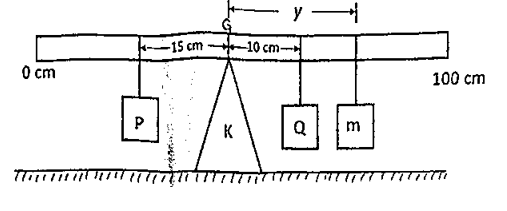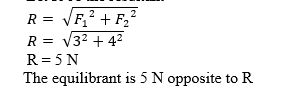Alternative A
Question 1A
(a)

You are provided with a metre rule, two loads, P and Q, a knife edge, K, a set of masses, m and a piece of string.
Use the diagram above as a guide to perform the experiment.
- With no loads hanging on the metre rule, balance the metre rule horizontally on the knife edge. Record the position, G, of the knife edge on the balanced metre rule.
- Suspend P securely at 15 cm from G, and Q securely at 10 cm from G.The positions of G, P and Q should not be altered throughout the experiment.
- Using a mass, = 40 , balance the metre rule horizontally. Measure and record the distance, y, of m from G.
- Evaluate m-1.
- Repeat the procedure for m = 50 g, 60 g, 70 g and 80 g. In each case, record the distance, y, and evaluate m-1.
- Tabulate the results.
- Plot a graph with m-1 as ordinate and y as abscissa.
- Determine the slope, s, of the graph.
- Determine the value of given that 15
- From the graph, deduce the mass, m, that would produce a balance distance, .
- State two precautions taken to ensure good results.
(b) (i) State the two conditions necessary for a body to be in equilibrium
(ii) Two forces 4 N and 3 N act at right angles to each other, calculate the equilibrant of the system of forces.
Observation
WEAKNESSES: The candidates mistakenly swapped the axes because they could not tell the difference between the y-axis (ordinate) and the x-axis (abscissa).
STRENGTH: Ability to carry out the instructions and record observations as required.
EXPECTED RESPONSE:
OBSERVATIONS [09]
- Reasonable value of G correctly determined and recorded to at
least 1 d.p. in cm.
(ii) Five values of m correctly recorded in grams
(Deduct ½ mark for each wrong or missing value)
- Five values of y correctly determined and recorded to at least 1 d.p.
and in trend.
Trend: As m increases, y decreases.
(Award 1 mark each)
- Five values of m-1 correctly evaluated to at least 3 d.p.
(Deduct ½ mark for each wrong or missing value)
- Composite table showing m, m-1 and y.
GRAPH [06]
- Axes correctly distinguished (Award ½ mark each)
- Reasonable scales (Award ½ mark each)
- Five points correctly plotted
(Deduct 1 mark for each wrong or missing point)
- Line of best fit
SLOPE (02)
- Large right-angled triangle
(ii) Dm-1 correctly determined
(iii) Dy correctly determined
(iv) correctly evaluated
DETERMINATION OF mp [01]
- Correct substitution
- Correct calculation
DEDUCTION OF m [01]
- Value of m-1 corresponding to y = 27.5 cm correctly shown
- m correctly evaluated
PRECAUTIONS [02]
Award 1 mark each for any 2 reasonable precautions stated in acceptable tense.
E.g.:
- Avoided draught
- Avoided parallax error in taking metre rule readings
- Repeated readings shown on table.
(b) (i) Conditions for a body to be in stable equilibrium
(α)
- There should be no net force on the object
OR
- The sum of forces in one direction must be equal to the sum of forces in the opposite direction.
(β)
The sum of the clockwise moments about a point is equal to the sum of the anti-clockwise moment about the same point.
OR
The net torque acting on the body must be zero.
II)

